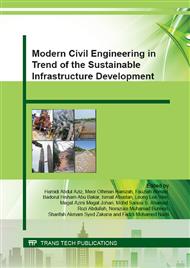[1]
Ahmad, M.H., Omar, R.C., Malek, M.A., Md Noor, N. and Thiruselvam, S. 2008. Compressive strength of palm oil fuel ash concrete. In: International Conference on Construction and Building Technology in Kuala Lumpur, Malaysia. 297-306.
Google Scholar
[2]
Karim, Md. R., Zain, M.F.M., Jamil, M. and Nazrul Islam, Md. 2011. Strength of concrete as influenced by palm oil fuel ash. Australian Journal of Basic and Applied Sciences. 5(5). 990-997.
Google Scholar
[3]
Chindaprasirt, P., Chotetanom, C. and Ruzkon, S. 2011. Use of palm oil fuel ash to improve chloride and corrosion resistance of high-strength and high-workability concrete. Journal of Materials in Civil Engineering. 23. 499-503.
DOI: 10.1061/(asce)mt.1943-5533.0000187
Google Scholar
[4]
Isaia, G. C. & Gastaldini, A. L. G. 2009. Concrete sustainability with very high amount of fly ash and slag. IBRACON structures and material. 2. 244-253.
DOI: 10.1590/s1983-41952009000300003
Google Scholar
[5]
Mehta, P. K. 2010. Sustainable cements and concrete for the climate change era-a review. In: J. Zachar, P. Claisse, T.R. Naik & E. Ganjian, Eds. Second International Conference on sustainable construction materials and technologies, Universita Politecnica delle Marche, Ancona, Italy.
DOI: 10.18552/2016/scmt4s138
Google Scholar
[6]
Price, W. 2009. Cementitious materials for the twenty-first century. In: Proceedings of the Institute of Civil Engineering - Civil Engineering. 64-69.
Google Scholar
[7]
Bagama, S.O., Hussin, M.W. and A. Ismail, M. 2013. Palm oil fuel ash: Promising supplementary cementing materials. Korean Society of Civil Engineering Journal of Civil Engineering. 17(7). 1708-1713.
DOI: 10.1007/s12205-013-1241-9
Google Scholar
[8]
Sooraj, V.M. 2013. Effect of palm oil fuel ash (POFA) on strength properties of concrete. International Journal of Scientific and Research Publications. 3(6). 1-7.
Google Scholar
[9]
Deepak, T.J., Albarra, E., Noor Hassan, Chakravarthy. N, Siow, Y.T. and Mithun, B.M. 2014. Investigation on properties of concrete with palm oil fuel ash as cement replacement. International Journal of Scientific & Technology Research. 3(1). 138-142.
Google Scholar
[10]
Sata, V., Jaturapitakkul, C. and Kiattikomo, K. 2004. Utilization of palm oil fuel ash in high-strength concrete. Journal of Materials in Civil Engineering. 16. 623-628.
DOI: 10.1061/(asce)0899-1561(2004)16:6(623)
Google Scholar
[11]
Abdul Awal, A.S.M. and Abubakar, S.I. 2011. Properties of concrete containing high volume palm oil fuel ash: A short-term investigation. Malaysian Journal of Civil Engineering. 23(2). 54-66.
Google Scholar
[12]
Sivasundaram, V. & Malhotra, V. M. 1992. Properties of concrete incorporating low quantity of cement and high volumes of ground granulated slag. ACI Materials Journal. 89. 554-563.
DOI: 10.14359/4027
Google Scholar
[13]
Zhang, M. H. & Malhotra, V. M. 1995. Characteristics of a thermally activated alumino-silicate pozzolanic material and its use in concrete. Cement and Concrete Research. 25. 1713-1725.
DOI: 10.1016/0008-8846(95)00167-0
Google Scholar
[14]
Day, K. W. 2000. Concrete mix design, quality control and specification, E & FN Spon.
Google Scholar
[15]
Escalante, J. I. & Sharp, J. H. 2001. The microstructure and mechanical properties of blended cements hydrated at various temperatures. Cement and Concrete Research, 31. 695-702.
DOI: 10.1016/s0008-8846(01)00471-9
Google Scholar
[16]
Lewis, R., Sear, L., Wainwright, P. J. & Ryle, R. 2003. Cementitous additions. In: Newman, J. & Choo, B. S. (eds. ) Advanced concrete technology : constituent materials. Butterworth-Heinemann.
DOI: 10.1016/b978-075065686-3/50279-2
Google Scholar
[17]
Ballim, Y. & Graham, P. C. 2009. The effects of supplementary cementing materials in modifying the heat of hydration of concrete. Materials and Structures/Materiaux et Constructions, 42. 803-811.
DOI: 10.1617/s11527-008-9425-3
Google Scholar
[18]
Aldea, C. M., Young, F., Wang, K. & Shah, S. P. 2000. Effects of curing conditions on properties of concrete using slag replacement. Cement and Concrete Research, 30. 465-472.
DOI: 10.1016/s0008-8846(00)00200-3
Google Scholar
[19]
Clear, C. 2009. Private Communication.
Google Scholar
[20]
Nehdi, M. 2001. Ternary and quaternary cements for sustainable development. Concrete International, April. 35-42.
Google Scholar
[21]
Tay, J.H. 1990. Ash from oil-palm waste as concrete material. Journal of Materials in Civil Engineering. 2(2). 96-105.
Google Scholar
[22]
Chindaprasirt, P., Homwuttiwong, S. and Jaturapitakkul, C. 2007. Strength and water permeability of concrete containing palm oil fuel ash and rice husk-bark ash. Construction and Building Materials. 21. 1492-1499.
DOI: 10.1016/j.conbuildmat.2006.06.015
Google Scholar


